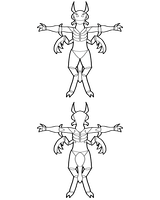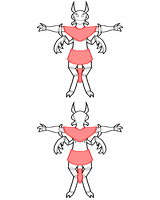Drili Species
HayTheWeirdo
- Created
- 3 months, 4 days ago
- Creator
- HayTheWeirdo
- Favorites
- 4
Profile
General Anatomy
✖-----✖
How many limbs do they have? Do they have limbs at all?
4 grasping limbs, 2 walking limbs, 1 balancing limb, and a head.
What kind of body covering do they have, e.g. hair, scales, feathers? How do they clean it? Do they shed this covering constantly, or all at once at certain times?
They have a calcium carapace, and clean it through allogrooming or a water solution that's similar, they shed different parts consistently over a cycle that allows only one weak spot at a time.
Can they maintain a constant body temperature? If not, how do they deal with changing environmental temperatures?
Yes, their blood slowly can aclimate to near any tempearture.
What kind of habitat do they live in? Both specific habitat, and broader such as on land vs in water.
They live in forested lake areas, but can live in most environments as long as adequate hydration is available.
What resource(s) is the most necessary and urgent for them? E.g. for many animals, but not all, it’s water.
Water and calcium, Water to keep hydrated and calcium to keep their carapace from getting to weak and collapsing.
What are some common mutations? E.g. eye colours, ability to digest lactose in humans.
Any pigment mutation in eyes, skin, and carapace, ex. Vitiligo, Albinism.
What injuries or illnesses are considered disabling?
Along with Deafness, Muteness, and Blindness they can have the Inability to digest Calcium as a disability. For Illnesses, along with autoimmune illnesses/disorders they can have a carapace-thinning disorder/illness, which limits calcium processing and makes it difficult to walk and using their limbs.
✖-----✖
Senses
❤-----❤
What senses do they have? E.g. sight, smell, electroreception, etc.
Touch, Taste, Hearing, Partial infrared vision with mainly color vision, Pheromones.
How good are those senses?
Their infrared vision is weaker than their color vision, only highlighting things that are hotter, their taste is there but weak, their other senses are basic with pheromone detection being slightly better.
Which of their sense/s do they use the most in everyday life?
Hearing and pheromones, for communication.
❤-----❤
Movement
☀-----☀
How do they move? Do they walk, crawl, fly, etc?
They can walk, crawl, and climb, they mainly walk on two limbs.
What is their speed and endurance like?
They are ambush hunters endurance is low but speed is high, think cheetahs.
How agile are they?
They are very agile and can run in short but fast bursts of speed
Do they rely mainly on their own bodies for travel, or do they use pack animals and machines?
It is not uncommon to walk to train their endurance but often they use vehicles.
☀-----☀
Reproduction and Lifecycle
☁-----☁
How many sexes are there?
2, male and female.
Are there differences between the sexes (ignoring the reproductive system)?
Females tend to have slimmer and more flexible tails and males tend to have brighter colors.
Do they have a concept of gender? If so, is gender affected by sex, caste, or some other factor?
They do, gender is influenced by size and sex, making four binary genders. Their heights, excluding disorders, range from 6' to 7'.
How do they attract a mate? Do they release a chemical into the air, do an elaborate display, etc?
Taller Drili are expected to seek out one or two of the opposite sex and go through an elaborate courting process.
How long do they live?
Average lifespan is 100 earth-years.
How are young brought into the world? Live birth, eggs, spores, etc?
Eggs are laid by females.
How much parental investment is there? Are there many young with little investment, or few young with a lot of investment (r vs K strategy)? Or is it somewhere in the middle?
Little thought are given to where eggs are laid as they can survive harsh conditions, but hatchlings are weak and given tons of care that is slowly lessened until they become adults.
What is the usual structure of childcare? Single or multiple parents/related individuals? Communally raised?
Best example I can give is wolf pack mixed with lion pride, Parents in 2-6 individuals to groups raise their kids with occasional older family members helping.
☁-----☁
Diet and Foodchain
♦-----♦
What is their diet? Are they carnivores, omnivores, frugivores, insectivores, etc?
They are mainly carnivores.
Is their diet very restricted, or can they have a wide range of foods?
They can eat many foods other than meat, it just won't be as good for them.
How often do they eat? What is the culture around mealtimes, if any?
They eat twice a day, one large meal to sustain them through the day and then a smaller but still large meal to carry them through the night.
If they are hunters themselves, what is their attitude to killing other organisms? Are they respectful? Prideful of their kill? Is it completely trivial?
It's mostly trivial, but most have the mindset of "it was alive too so treat it well.".
If they are hunters, how do they hunt? Are they solitary or packhunters? Are certain members of the group designated to hunt?
Certain members of their packs are designated hunters, and those hunters usually go and hunt solo but will occasionally hunt in groups for large prey.
Are the results of foraging or hunting shared, or is it everyone for themself?
All food, even junk foods, are shared.
♦-----♦
Body Rhythms
❄-----❄
How often do they sleep?
One long rest through the night everyday.
What time of the day are they most active? Are they nocturnal, diurnal, crepuscular?
They are diurnal and are most active right after sunrise after mealtime.
Do they generally sleep for one long period a day, multiple shorter periods throughout, or something in between?
They can sleep in shorter naps through the day if they wish to be up at night, but most decide culturally for one long rest.
Do they have any biological processes that disrupt their life e.g. moulting, reproductive cycles, etc?
Molting is disruptive but mostly just annoying, mating season is a big one but in modern times can be repressed.
If yes, how does their society accommodate for these processes? Does it accommodate them at all?
Molting can be a solo thing but most often friends and family may help an individual, during mating season some jobs may let workers go on a break but most often when not wanting to reproduce the populace takes medicine to repress it.
❄-----❄
Communication
♬-----♬
What is their main method of communication? Sound, visuals, scent, etc? Think about their main sense and how this would affect communication.
Their main method of communication is auditory, but they use pheromones to communicate tone and emotion in their language .
What is their body language like? What small moving parts might aid their body language?
They are very tactile, personal space is trivial to friends and family, to strangers they're more closed off but still friendly. Antennae, secondary arms, and mandibles all work in providing smaller details as they speak in aid with pheromones.
If they have multiple methods of communication, are they all given equal weight, or is one considered higher than others?
Auditory speaking is higher over pheromones, and pheromones are higher over body language.
♬-----♬
Society
☯-----☯
How sociable are they?
They are a very social species.
How are disputes usually settled? Is it more common to be violent or appease the other party?
Disputes are usually settled by getting someone completely unrelated to the situation to come up with something to appease both parties.
What is the usual size of a community? Do they have communities at all?
Communities can very vastly in size, it all depends on how many at the top of the order chose to stick together. The lowest a community can be is some parents(2-4) raising the min amount of kids(4) to the largest being multiple groups of parents(2-6) with some of their birth family members raising the max number of kids(10). And that's not bringing into considering bringing friends and adoptive members into the mix.
On the spectrum of individualistic to community-oriented, where do they fall?
Right in the middle, they like individuality but definitely value community values.
Do they have names? If yes, how are these names formed? Are they given by another party or chosen by the individual?
When hatched they are given a name by parents, but once they reach adulthood they are given the option to keep their name or change it.
Do they produce art? What are their main forms of artistic expression? Think about how this will be linked to their main sense(s), communication method, and/or primary manipulators.
They love music, be it raw vocals or only instruments their cultures are rich with music, like how Humans constantly draw and mark where they can Drili constantly make music and share that music to whoever they can.
☯-----☯
TLDR: The Drili are a bipedal insectoid species hailing from the planet Sciuxul. Questions from Here.

